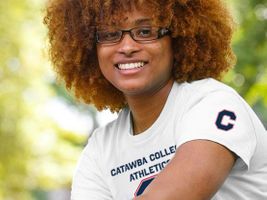By Rebecca Rider
Conservation veteran Eugene Hester shared his wood duck adventures with 75 people September 27 at the Center for the Environment facility on the Catawba College campus.
A wildlife photographer and author, Hester taught at N.C. State University and served as deputy director of the U.S. Fish and Wildlife Service, assistant director of the Park Service, and deputy director of the U.S. Biological Survey.
His true passion, however, is wood ducks. Hester has been studying and boosting wood duck populations for nearly 60 years. With the release of his new book, Wood Duck Adventures, he showed slides and talked about his life-long love of the colorful waterfowl with attendees, beginning with his first encounter.
His journey started, he says, "when I learned that wood ducks nest in trees. That blew my mind." A young student at the time, Hester crafted his own duck lodge. When a wood duck couple eventually nested there, "that lit a fire under me," Hester said. He has been working with the birds ever since. But it wasn't easy at first: "In the beginning, I tried to hide my nests from the ducks. I put them so far back and camouflaged them so well that the ducks couldn't find them!"
A major milestone in Hester's career was the partnership he formed with Jack Dermid, a wildlife photographer. Hester described it as an agreement that changed both their worlds. “He told me a lot about photography and I told him a lot about wood ducks." This sharing of knowledge allowed Dermid to get close to the shy birds and let Hester gain skills he would use to become a renowned wildlife photographer in his own right.
Audience members got to see what a good team the two made when Hester played a short video he and Dermid shot of day-old hatchlings leaping from the nest – which can be built as high as 50 feet above ground. "They don't fall out," Hester said, "They jump out!"
Hester also detailed how he began placing tags on nestlings. This enables conservation groups to track the ducks and learn about their migrating habits. Because of the tags, he was able to discover that a wood duck hen will march her newly hatched brood as far as four miles in order to find the perfect spot to raise them. In spite of their amazing ability to survive and travel, life is hard for the birds. They are the number one waterfowl killed by hunters, because wood ducks don't migrate in the winter: "It's because [they're] right there in the local creeks and ponds."
Between hunters and predators, their numbers are difficult to keep up. That has prompted Hester to establish weather and predator-proof nesting boxes to help the birds repopulate. So far, he's been successful. He reported that there are more wood ducks today than there have been for a century.
The Center for the Environment at Catawba College was founded in 1996 to provide education and outreach centered on prevalent environmental challenges and to foster community-oriented sustainable solutions that can serve as a model for programs throughout the country. For more information, visit www.centerfortheenvironment.org or www.campaignforcleanair.org.
RELATED CONTENT:
Wildlife Photographer to Speak at Center for Environment at Catawba College
